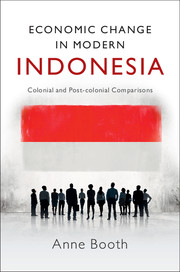Book contents
- Frontmatter
- Contents
- List of tables
- Acknowledgements
- 1 Introduction: Indonesia's three watersheds
- 2 The colonial legacy
- 3 Occupation, liberation and the challenges facing the new republic, 1942–66
- 4 Suharto's economic record: successes and failures
- 5 The 1997–98 crisis and its legacy: dropping out again?
- 6 The SBY years: building a new Indonesia?
- 7 Economic nationalism, economic rationalism and the development of private business after 1950
- 8 Trends in poverty and income distribution: the Suharto era and beyond
- 9 The changing role of government from the colonial era to the post-Suharto years
- 10 Conclusions
- Bibliography
- Index
3 - Occupation, liberation and the challenges facing the new republic, 1942–66
Published online by Cambridge University Press: 05 February 2016
- Frontmatter
- Contents
- List of tables
- Acknowledgements
- 1 Introduction: Indonesia's three watersheds
- 2 The colonial legacy
- 3 Occupation, liberation and the challenges facing the new republic, 1942–66
- 4 Suharto's economic record: successes and failures
- 5 The 1997–98 crisis and its legacy: dropping out again?
- 6 The SBY years: building a new Indonesia?
- 7 Economic nationalism, economic rationalism and the development of private business after 1950
- 8 Trends in poverty and income distribution: the Suharto era and beyond
- 9 The changing role of government from the colonial era to the post-Suharto years
- 10 Conclusions
- Bibliography
- Index
Summary
A decade of struggle
In 1942, the armed forces of imperial Japan swept through British Malaya, Indonesia and the Philippines, inflicting humiliating defeats on the colonial governments and armies. The myth that European colonialism was invincible was destroyed in a few weeks of conflict. In many parts of Indonesia the Japanese were greeted as liberators and especially in Java there was little overt opposition until 1944 (Abdullah 2010). Nationalists were released from prison; Sukarno and Hatta cooperated with the Japanese, mainly ‘in the interest of the greater goal of independence’ (Ricklefs 2001: 251). Other prominent nationalists, including Sjahrir, avoided overt cooperation with the Japanese, and built up an underground network based on former colleagues. For their part the Japanese promoted many Indonesian government officials into more senior posts to replace Dutch nationals who had either fled or been imprisoned.
The Japanese placed considerable emphasis on mobilising and indoctrinating youth. Following Japanese policy in both Taiwan and Korea, the school system was used to instil Japanese values into children along with a sense of nationalism. The evils of Dutch colonial policy were also stressed (Kurasawa 2010: 323). On the economic front, the Japanese gave top priority to the petroleum sector, where they urgently needed supplies to replace imports from the USA and elsewhere. Technicians quickly repaired the damage inflicted on the oilfields in Sumatra and Kalimantan by the departing Dutch. Crude oil production doubled between 1942 and 1943. Rubber production was also encouraged, but other export crops including sugar, spices, coffee and tea were not accorded high priority. Sugar was procured from Taiwan, and scarce shipping capacity could not be used to transport luxury goods such as coffee and spices to the Japanese mainland.
The Japanese paid little attention to the colonial borders and governed Southeast Asia according to their own strategic needs. Sumatra along with peninsular Malaya was governed from Singapore, while Borneo and most of the eastern islands were controlled by the navy. Problems of food supply rapidly emerged across the archipelago (Sato 2010: 267–79). Indonesia as a whole had been a net rice importer prior to 1942, relying on Thai, Burmese and Vietnamese imports to supply deficit areas in Sumatra, Java and elsewhere. These supplies were greatly reduced, partly because the Japanese needed the rice to supply to their own troops and partly because it was decreed that regions should be ‘self-sufficient’.
- Type
- Chapter
- Information
- Economic Change in Modern IndonesiaColonial and Post-colonial Comparisons, pp. 35 - 62Publisher: Cambridge University PressPrint publication year: 2016

